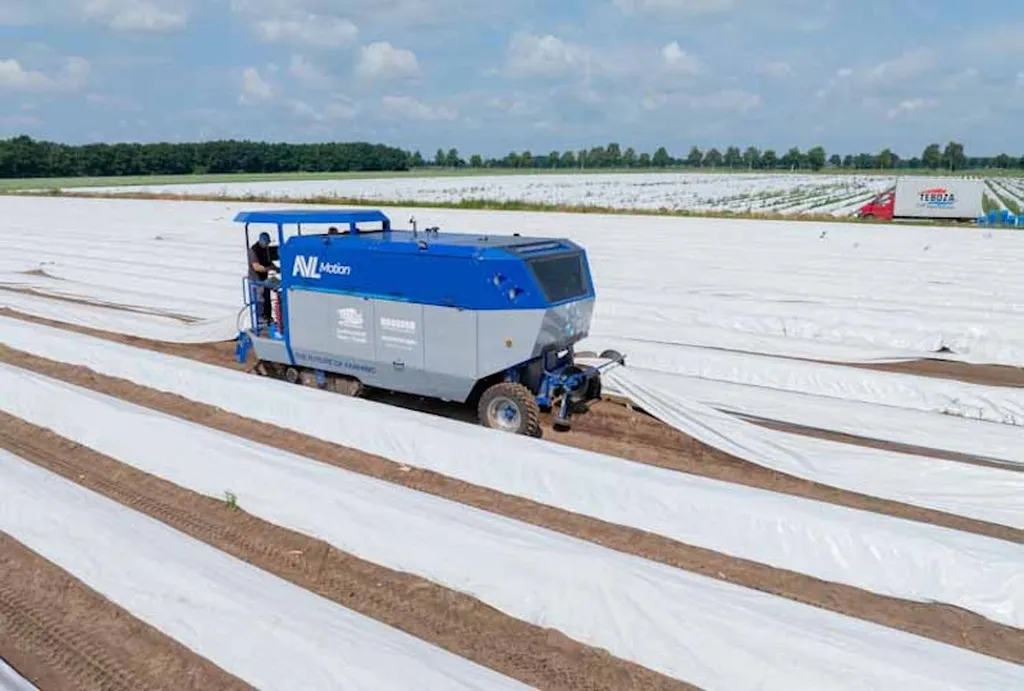In a significant stride towards automating high-value vegetable crops, field trials conducted by Wageningen University & Research (WUR) and Dutch grower Teboza have demonstrated that the AVL Compact S9000 asparagus harvesting robot can match the yield and quality of human pickers while operating three to four times faster under typical conditions. This development marks a substantial leap in agricultural technology, with potential implications for the future of asparagus farming and beyond.
The AVL Compact S9000, developed by AVL Motion, is an autonomous, selective harvesting robot equipped with twelve harvesting modules. It boasts a technical capacity of 9,000 harvesting actions per hour, a feat that, under optimal conditions, could reach up to ten times the speed of human pickers during peak growth periods. The robot identifies asparagus by detecting the tip of the spear and directs a harvesting module towards it while moving. The module, consisting of a pneumatically driven cylinder with a cutting mechanism, inserts itself into the soil around the asparagus, cuts it at the base, and lifts the spear onto a conveyor belt for collection.
The field trials, conducted on a well-prepared asparagus field with weed-free, straight ridges and paths, revealed no significant difference in the weight of marketable asparagus between machine and manual harvesting. According to WUR researcher Damian Teuns, the robot cuts asparagus slightly shorter than manual harvesters but still to at least 25 cm in length. After trimming to 25 cm for processing, the total weight of marketable asparagus is comparable. Moreover, the quality of the harvested asparagus, in terms of thickness, length, straightness, tip condition, and absence of damage, showed no significant difference between the AAA, AA, A, and B+C classes.
However, the trials did reveal a shift in grading. Manual harvesters collected more coarse asparagus, while the robot produced more tips and hollows. This shift is assumed to occur because the harvesting mechanism cuts thick asparagus halfway or damages it if it grows curved or at an angle, leaving only the tip. Further research is needed to understand the increase in hollow asparagus.
The trial results have been met with enthusiasm by AVL Motion’s managing director, Sander Wientjes, and financial director, Raymond van den Bos. They highlighted that the robot’s technical capacity of 9,000 harvesting actions per hour under optimal conditions averages around 3,000, with peaks up to 6,000 per hour. This speed is a significant improvement over manual harvesters, who pick around 300 asparagus per hour.
Teboza director Rik Kursten emphasized that the harvesting robot must replace a certain number of manual harvesters to be profitable. When yields are high, the robot can replace six to seven workers, but this number drops when yields are lower. He also noted that the comparison with manual harvesters was based on a limited timeframe and that the robot’s advantage lies in its consistent performance throughout the day and in various weather conditions.
The implications of this technology are profound. The AVL Compact S9000 could address labor shortages in agriculture, reduce production costs, and improve harvesting efficiency. Moreover, its ability to work consistently and in various conditions could lead to more sustainable farming practices. As the technology continues to evolve, it may pave the way for further automation in high-value vegetable crops, transforming the agricultural landscape as we know it.

